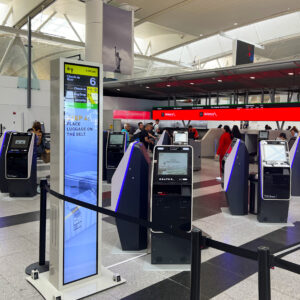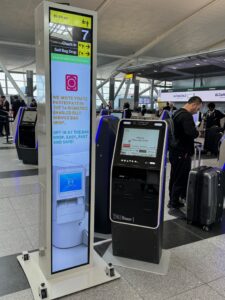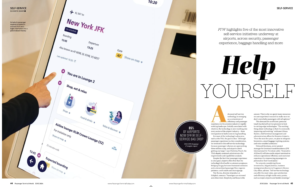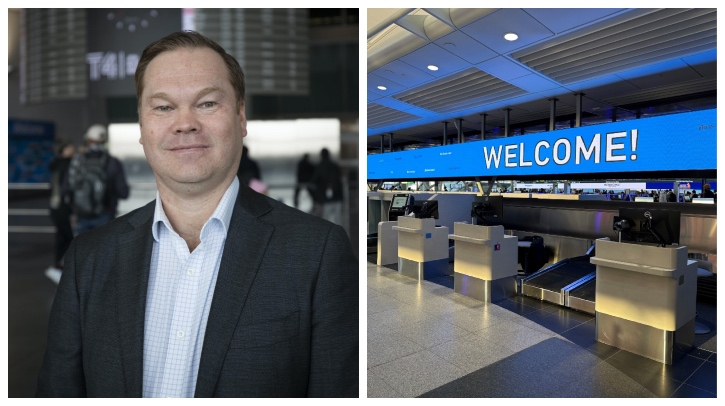Steve Tukavkin, vice president of IT and digital at JFK Airport Terminal 4, speaks to Passenger Terminal Today about the inner workings of the airport’s ongoing self-service mission
JFKIAT – the operator of Terminal 4 at New York’s JFK Airport – began implementing its self-service technology initiative in 2023. With this technology, passengers can check in and print their bag tag at one of 86 Amadeus kiosks before dropping their bag at one of the 42 Series 7 Auto Bag Drop units. To keep the technology flexible for the future, all kiosks and bag drops have been equipped with a biometric function.
What were the goals of this self-service initiative? What lessons have been learned?
Since embarking on our transformation journey at Terminal 4 more than two years ago, JFKIAT has been committed to introducing technologies that will improve the passenger experience overall, including self-service technology. As part of our extensive Terminal 4 transformation and redevelopment plans, the primary objective for the self-service technologies is to provide operational efficiency and offer an enhanced experience for passengers traveling through our terminal. The self-service Next Generation Kiosks and Auto Bag Drop units were implemented in T4 to increase the check-in and bag drop capacity, create a smooth and efficient passenger flow through the terminal, and give passengers more control over the process.
Implementing self-service technology in a common-use environment successfully involves several lessons learned. For example, early airline engagement is not only important from a technical perspective but also airline change management and staff training. Alongside this, user-centric design is a critical element to ensure that digital signage is carefully designed to provide intuitive navigation. The project also highlighted how important it is to ensure airlines’ self-service check-in applications are accessible to all passengers including those with disabilities. Finally, we found that it’s imperative to have a phased rollout implementation to manage risks and ensure a smooth transition from a conventional check-in process.
What are your plans for the next five years of self-service technology?

Following the introduction of common use self-service at T4 in 2023, we recently began a soft launch of biometrics at the self-service bag drop units in partnership with TSA and several airlines. JFKIAT is taking advantage of facial recognition technology to simplify the self-service experience by automating the process of identifying and matching passengers to their booking without the need for boarding pass scanning. We are evaluating the pilot with TSA and hope to enable facial recognition and expand the solution to other airlines soon.
In the meantime, as we construct and transition the last ticket row to common use self-service, we are continuing to review and optimize the new check-in processes with each of our airlines by analyzing passenger flow, kiosk utilization and transaction times at the auto bag drop units. Some of the initial outcomes are enablement of early check-in and bag drop to help with our arrival curve and reduce our peaks at the security checkpoint to help improve the passenger experience.
Additionally, as part of our new Information Zone concept, we will be deploying a new passenger experience solution with self-service units to bring a number of technologies together to ensure passengers get relevant information in a fast and friendly way, but also to provide them with a personalized journey. This year, JFKIAT will also introduce new digital signage to showcase dynamic walking times and increase engagement with passengers through tailored customer experience and marketing content.
The future of common use self-service technology is in a very exciting phase with the enablement of biometrics in the US and there has been a lot of interest from other North American airports and airlines to visit JFK Terminal 4 to see our digital transformation take shape as we have deployed over the past 12 months.
IATA’s CUSS 2.0 will further modernize the capabilities for mobile application support, enhanced secure payment methods aligned with PCI-DSS standards, as well as many other new enhancements. In the not-too-distant future, JFKIAT sees airlines enhancing their interactions with passengers, by equipping airline agents with mobile tablets that will be able to handle exceptions such as passenger acceptance, visa document checks and ancillary excess baggage payments right at any location during the self-service check-in journey without having to go back to a static check-in counter.
What are the key challenges of self-service technology at the airport?
The key challenges include ensuring system reliability and seamless integrability with interfacing systems, such as airline departure control systems or airport/terminal systems. These challenges can be overcome through systematic testing procedures to identify and address potential issues before deployment, as well as continuous monitoring to ensure smooth operation and compatibility with existing infrastructure.
Where can self-service offer the most value and what are the key technologies driving its development?
With the introduction of the Next Generation Kiosks and Auto Bag Drop units, T4 passengers can easily check in, print their own bag tag and self-tag using linerless bag tags before dropping their bags in a matter of seconds at one of the bag drop units. The deployment of this self-service technology allows for an eased passenger process and flow at check-in.
The opt-in biometrics solution automates the TSA required ID verification that airlines must perform before passengers induct their luggage. When a passenger opts in and uses biometrics at the bag drop, they will use facial recognition against the CBP Traveler Verification System (TVS) database to identify who they are without having to scan their boarding pass in order to initiate the transaction at the bag drop.
How can self-service technology be optimized for increased customer satisfaction and revenue in the most cost-effective manner?
By introducing self-service technology at the check-in process, we have helped reduce stress during the passenger experience and have increased efficiency. As a result, airport staff and airlines can better manage their resources. Additionally, our opt-in biometric technology provides a better passenger experience and enhances security.
How best can airports balance customer satisfaction and airline relationships with airport revenue?
Balancing customer satisfaction, airline relationship and terminal revenue is a multifaceted challenge requiring a strategic approach. Investing in passenger experience technologies like common use self-service can lead to higher customer satisfaction and an increase in non-aeronautical revenue through retail and food and beverage (F&B) sales. By streamlining processes not only at check-in but also at the security checkpoint, you can reduce wait times and enhance the passenger experience. By using data analytics, we can also identify pain points and optimize planning and terminal efficiency.
For more of the top insights into the future of self-service airports, read Passenger Terminal World’s exclusive feature, How are airports around the world innovating their self-service offerings?, here


